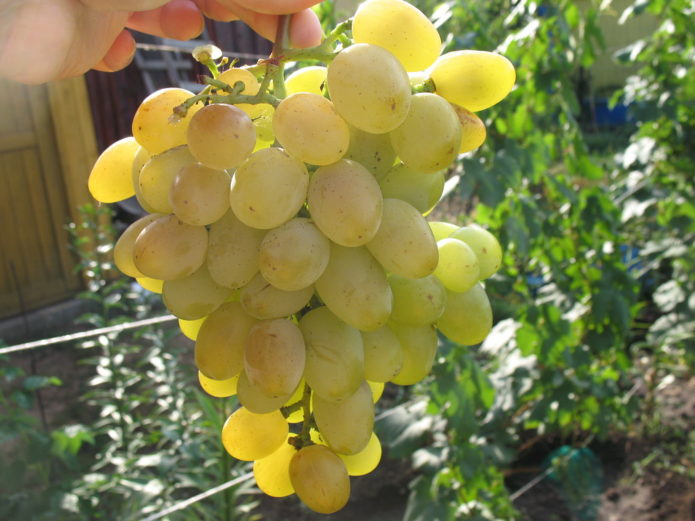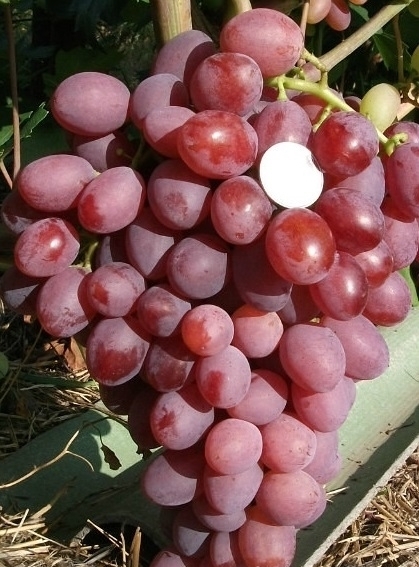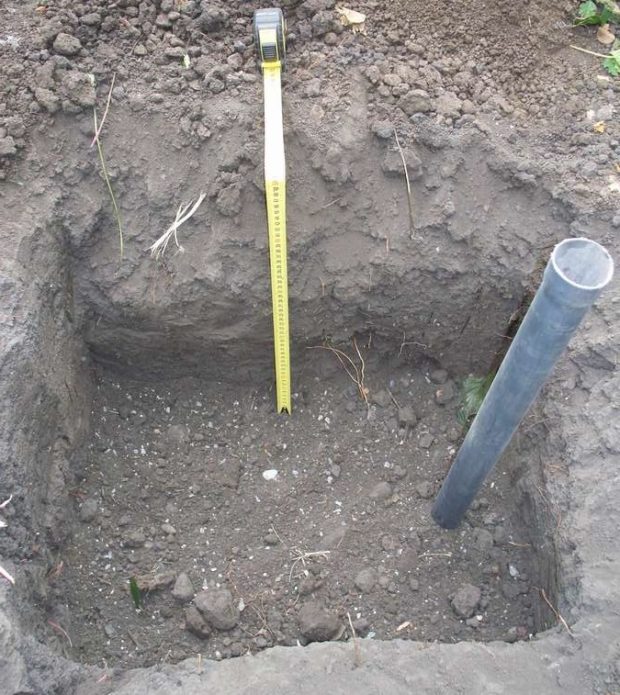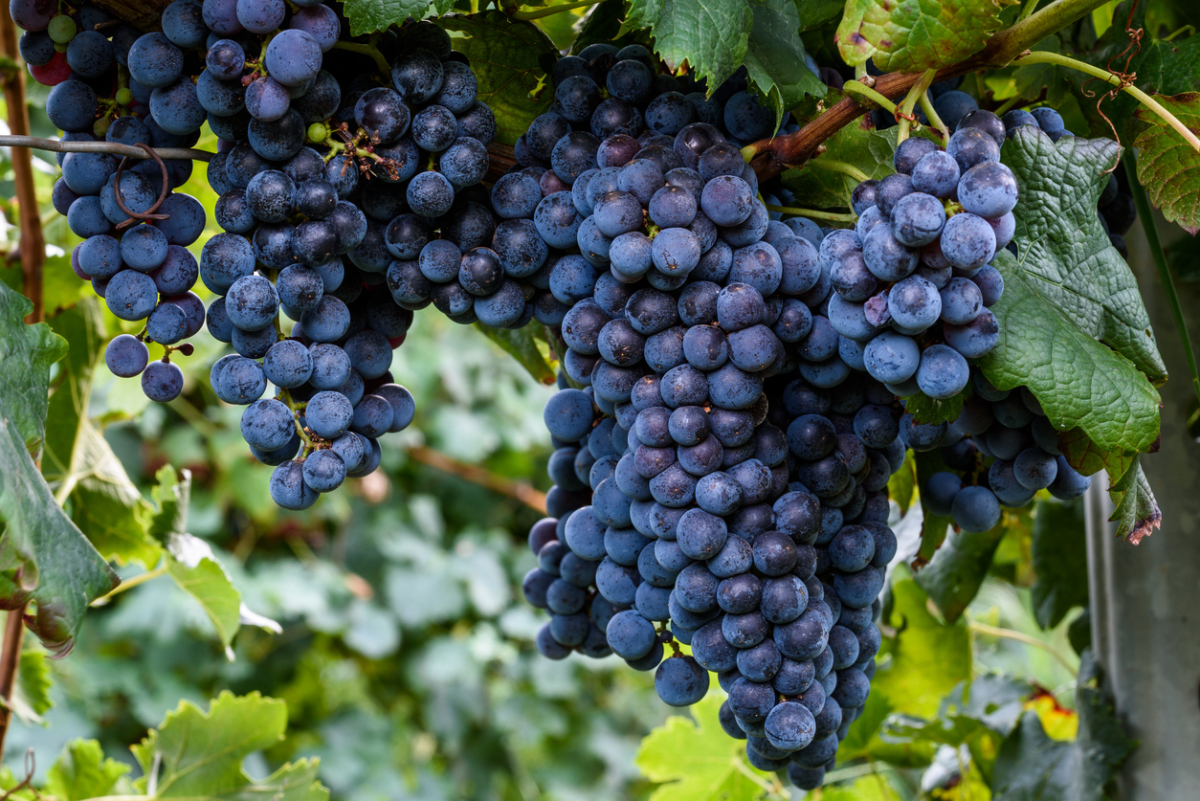We are always looking forward to spring and then summer; we are waiting for you to enjoy the first vitamins from your garden, therefore, when growing any plants, we are interested, first of all, in the earliest varieties. This fully applies to grapes. One of the earliest varieties of grapes is the very recently appeared table variety Ruta, which has many advantages.
Content
Breeding history, description and characteristics of the Ruta grape variety
The Ruta grape, created by the Ukrainian breeder Vitaliy Zagorulko, is a very young variety, it gained fame only a few years ago. V.V. Zagorulko, who lives in Zaporozhye, is currently one of the most famous winegrowers, constantly experimenting with table varieties and producing new interesting products almost every year.
Interestingly, in his main profession, the enthusiast has nothing to do with agriculture, about 40 years ago he received the qualification "electronic engineer" and worked in the field of strengthening the country's defense capability. However, from a young age he became interested in viticulture, which became his main business.
Today V.V. Zagorulko is the author of more than two dozen well-proven grape varieties, including the well-known superearly Libya and Sofia. Previously, he focused on breeding varieties with pink berries, now they have become more diverse in color.
The main direction of V.V.Zagorulko's work is the breeding of grape varieties of a very early ripening period, with large fruits, resistant to diseases and, if possible, frost-resistant. The Ruta variety almost fully meets these criteria. In terms of ripening, it can be attributed to ultra early, since the growing season is just over three months (from the appearance of the first leaves to harvest, 95–100 days pass). In the homeland of the variety, in the Zaporozhye region, the first berries are ready for use in the last days of July.
Ruta is obtained by hybridization of the well-known varieties Talisman and Kishmish Radiant. Ruta's bushes are very large, the vine grows quickly, and when young it has a reddish color. The author himself warns against using too large doses of fertilizers, including top dressing, in the summer: this, as a rule, leads to overgrowth of the bush to the detriment of the ripening of the vine and fruits. With proper agricultural technology, the shoots ripen almost to the full length. The leaves on the bushes are also very large, with a high dissection, the five-lobed shape common to most varieties.
The author assesses the resistance of the variety to mildew diseases as high, to powdery mildew and gray rot - slightly above average. Frost resistance at the level of most modern varieties - Ruta can withstand temperatures down to -21 aboutC. Propagated by all known methods, rooting of woody cuttings is good.
Ruta's bunches have a conical shape, medium or large, their weight is from 500 to 800 g, berries are packed in bunches of medium looseness. V.V. Zagorulko believes that the variety does not require normalization of the crop: all incipient inflorescences, and therefore the clusters, can be left on the bushes, the plant has enough strength to stretch the entire crop. The berries do not have to be picked immediately after ripening: they are perfectly preserved on the bushes for one and a half to two months. A relative disadvantage is that the grapes have only female flowers, and for their pollination, it is necessary to have another variety of grape bushes in the neighborhood, blooming at the same time as Ruta. The best pollinator is the well-deserved early variety Arcadia.
Ruta's berries are large, you can even call them very large: they reach a size of 3.6 x 2.2 cm and a weight of 12 g, elongated, pink in color. In certain periods of ripening, crimson and amber-yellow shades also appear in the color. The pulp is dense, the skin is thin, when the berries are consumed, it is not felt. The taste is assessed as ordinary grape, harmonious. A slight nutmeg aroma is not always present; it manifests itself most clearly when growing grapes on sandy soils. Many tasters note that the berries have a cherry flavor. Sugar content is high: up to 21%, acidity at the level of most varieties (about 7 g / l). The berries are well stored and do not spoil when transported over long distances, which is one of the positive signs of the Talisman variety, which participated in the birth of Ruta.
Like most of V.V.Zagorulko's combs, Ruta is not very suitable for central Russia, but feels great in the Central Black Earth Region and further south. In addition to Russia and Ukraine, it is already grown in Moldova and the southern regions of Belarus. The yield of the variety is relatively high and, which is important, stable. The first berries can be tasted as early as the second year after planting. The use is universal: the berries are good both fresh and in the form of compotes or juice, they are quite suitable for winemaking.
Video: ripening grapes Ruta
Features of planting and growing grape varieties Ruta
According to the testimony of numerous winegrowers who planted Rutu on their plots, which coincide with the opinion of the creator of the variety, its agricultural technology does not differ in any way from that for most modern super-early large-fruited grape varieties. Separate nuances are associated with the fact that the bushes are characterized by high vigor, and the flowers are not bisexual.
This grape is capable of growing normally in any soil, but the best option would be black soil with a high content of nutrients. The choice of a site for planting should be based on the fact that the variety works best in well-sunlit places, protected from the effects of cold winds by any tall buildings. Since Ruta's bushes are very large, a distance of at least 3 meters must be maintained to the nearest plantings (vines, other bushes, crowns of fruit trees). In addition, due to the high growth force, it is necessary to immediately provide for the arrangement of strong trellises of sufficient height.
The easiest way is to plant grapes by cutting; in the southern regions, landing is possible directly into the ground, to a permanent place. It is better to grow a seedling from the cuttings in advance, which is performed according to generally accepted methods. When buying a ready-made seedling, you should pay special attention to the condition of the root system. The optimal time for planting seedlings grown from cuttings this spring is the end of May, overwintered plants last year is April. In the south, it can be planted in the fall, but at the same time, it is desirable to have an easy cover for planting for the winter.
Site preparation is carried out in the previous summer and consists of digging with the usual doses of fertilizers. In the fall, dig a hole measuring 70 x 70 cm or slightly larger.When planting several bushes, it is more convenient to dig a planting trench with a depth of 60 cm. At the bottom, a 15-centimeter drainage layer is required (gravel, pebbles, other similar materials), any pipe is carried out there, so that in the first years the bush is watered directly along the roots. The lower half of the pit is filled with soil mixed with fertilizers (two buckets of humus, 0.5 kg of nitroammophoska, a couple of liters of ash), the upper half is filled with fertile soil without fertilizers.
Spring planting is carried out so that no more than two buds remain on the surface, but the roots are in contact only with the soil free of fertilizers. After planting, the bush is well watered, and the soil around it is mulched with any loose material. In the first year, watering is needed abundant and frequent, then their number is significantly reduced.
Annual care, in addition to periodic watering, consists of spring feeding, preventive spraying and competent pruning. Adult shrubs do not require much water, they themselves extract the necessary moisture from the deep layers, but they like periodic loosening of the surface layer of the soil. The greatest need for water is during the filling of berries, but already 2–3 weeks before the harvest is ready, watering is contraindicated. In the case of dry autumn, winter watering is useful before covering the bushes.
When feeding, you should not get carried away with nitrogen. Most of all grapes need potassium, so do not limit it in wood ash: every spring you can scatter half a bucket of this valuable fertilizer around the bush and slightly embed it in the soil. The introduction of well-rotted manure (1-2 buckets) is necessary once every two years, in the holes dug along the periphery of the bush. Immediately before flowering, you can spray the leaves with a weak solution of any complex fertilizer, but the dose should not be large: Ruta can do without systematic foliar dressing.
The resistance of the variety to diseases is above average, but for preventive purposes, early spring treatment of the vines with a solution of ferrous sulfate will not interfere. If you are late and the leaves begin to move, the recipe must be replaced with 1% Bordeaux liquid. Other treatments should be used only if signs of disease appear.
Pruning Ruta is relatively easy, as she is not very prone to stepchildren and thick bushes. There is no need to remove extra inflorescences. Therefore, in the spring, they carry out cosmetic pruning, removing vines that have not overwintered and obviously unnecessary shoots, and throughout the summer they break out only shoots that grow not where the owner would like. The main pruning is carried out after leaf fall. At the same time, no more than 60 eyes are left in adult bushes: this is a very high indicator compared to the same type of varieties, it is believed that the bush is able to serve everything. At the same time, 6 to 8 buds are left on each shoot.
The incidence of wasps in the Ruta variety is small, so special protection is not required. True, a ripe crop is largely pecked by birds, so you have to take care of protection from their invasion. Mostly they use various scarecrows.
It is necessary to shelter these grapes for the winter everywhere, except for the most southern regions. But very serious cover is not required. It is enough to spread the vines removed from the trellises on the ground in convenient bunches and cover with spruce branches of pine or spruce, not forgetting to scatter around the preparations to protect against rodents. In the middle lane, this grape is still not grown much, but the owners of Ruta in the central regions have to add denser materials, such as roofing material or at least spunbond, to coniferous spruce branches.
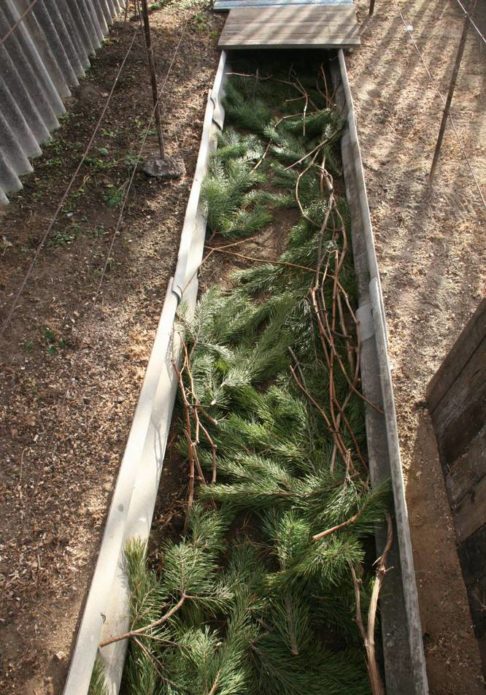
A good owner will build a box where he will lay the vines for the winter, and then cover them with spruce branches
Advantages and disadvantages of the variety in comparison with similar
- very early maturation;
- early entry of young plantings into fruiting;
- good presentation;
- interesting taste with a sweet cherry flavor;
- stable, although not very high, yield;
- the safety of berries on the bushes for a long time;
- excellent transportability of bunches;
- high disease resistance;
- ease of reproduction;
- lack of "peas" in the bunches;
- low susceptibility to wasps.
The list of relative disadvantages is also not very short:
- difficulties with pollination: it is necessary to have another variety of bushes with simultaneous flowering;
- not very good, by modern standards, frost resistance;
- large feeding area;
- susceptibility to phylloxera.
However, of course, the number of pluses significantly exceeds the number of minuses, and in its segment (very early table varieties with large berries) the Ruta variety is among the best.
Video: adult bushes of Ruta grapes
Reviews about Ruta
Despite the youth of the variety, the number of reviews about it on specialized forums is already quite large, and most experts highly appreciate the quality of Ruta grapes.
All good and health! Ruta on my site for three years, the first fruiting. She perfectly endured the last two snowless winters, her growth strength is good, with standard treatments there were no problems with diseases. Pollination last year was problematic and there were peas, and not all the clusters were well done, the average weight was 200–400 g. It ripened quite early, on August 2-3 it was ready, wasps love. With good sugar, it had a yellow-pink color, I decided to observe and left some of the bunches on the bush. The last season, due to the intense heat, created problems with coloring in my area in pink-colored forms, and Ruta for 10 days hung out and gained a bright pink color. Her taste is harmonious, the flesh is thin, the skin is not felt when eating. The first impression of Ruth is positive
Hello. Five fruiting ... In my opinion, I watched enough ... The ratio of vegetative mass / yield is not satisfied. 30 kg on two arms with a total length of approx. 7 m. Such "weeds", such health - rushing so that just think about what to do - ... and 30 kg ... - it will not be enough. And frost resistance is worse than the same Libya, at the level of Sofia.
So after 4 years of growing Ruta, I came to the conclusion that it is necessary to remove her. There really are no good bunches, the ridges are very fragile, break, and therefore even medium bunches fall into small pieces. Not the best variety Zagorulko, it is not suitable for sales at all, in general, 6 places are vacated for other varieties.
Ruta matured on July 29th and was brought to the market. Sugar got up to 22. It was sweet, with a sweet cherry flavor. Grafted on the Plevna bush last year - three sleeves. Pleven was not ready yet last weekend. The load on the bush is about 9-10 kg of Ruta and 15 kg of Plevna on the other shoulder. Yes, it was convenient to sell - bunches of 500-800 grams each, the berries are very large! The color is just wonderful! Has shown itself to be really super early!
Ruta grape variety is a good option for lovers of ultra-early pink berries. Unfortunately, it is not suitable for harsh regions, but in the southern half of our country, as well as throughout Ukraine, climatic conditions are quite suitable for growing it. The variety attracts attention due to its large, beautiful berries of good taste, their excellent transportability and resistance to most grape diseases.
